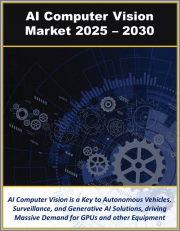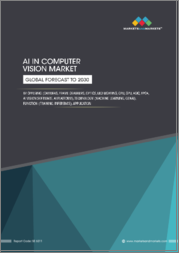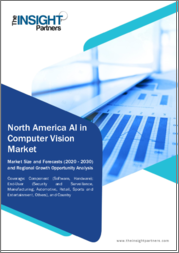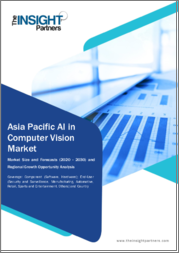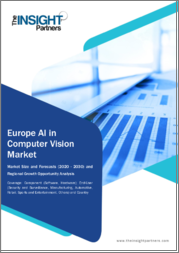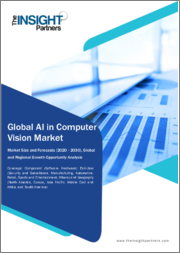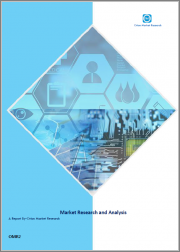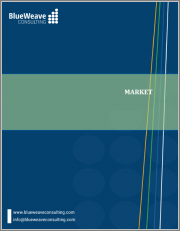
|
시장보고서
상품코드
1319278
컴퓨터 비전용 AI 시장 : 세계 시장 규모, 점유율, 동향 분석, 기회, 예측 보고서(2019-2029년)AI in Computer Vision Market - Global Size, Share, Trend Analysis, Opportunity and Forecast Report, 2019-2029, Segmented By Component ; By Function ; By Application ; By End Use ; By Region |
||||||
컴퓨터 비전용 AI 세계 시장 규모 5배 이상 확대, 2029년까지 1,230억 달러에 달할 전망
딥러닝과 뉴럴 네트워크의 발전과 시각적 분석의 자동화 및 효율화에 대한 수요가 급증하면서 전 세계 컴퓨터 비전용 AI 시장이 급성장하고 있습니다.
전략 컨설팅 및 시장 조사 기관인 BlueWeave Consulting은 최근 조사에서 2022년 컴퓨터 비전용 AI 세계 시장 규모를 240억 달러로 추산했으며, 2023년부터 2029년까지 예측 기간 동안 컴퓨터 비전용 AI 세계 시장 규모가 CAGR 26%의 견고한 성장률을 보이며 2029년에는 1,230억 달러에 달할 것으로 예측했습니다. 컴퓨터 비전용 AI 세계 시장의 주요 성장 동력은 품질 검사 및 자동화에 대한 요구 증가, 비전통 및 신흥 애플리케이션에서 컴퓨터 비전 시스템의 사용 확대, 감성 AI의 채택 등입니다. 산업 자동화를 촉진하기 위한 정부의 노력과 엣지 디바이스에 인공지능을 통합하는 것은 업계 참가자들에게 유리한 기회를 제공할 것으로 예상됩니다. 특히, 컴퓨터 비전 시스템 시장은 비전통적인 애플리케이션과 신흥 애플리케이션 모두에서 수요가 증가하면서 성장을 더욱 촉진하고 있습니다. 이러한 시스템은 검사, 식별, 측정, 제품 현지화와 같은 작업에 다양한 산업에서 적용되고 있습니다. 또한, AI 기반 비전 시스템의 다재다능함은 3D 모델링, 소매, 의료 영상, 광학 문자 인식, 자동차 안전, 감시, 교통 모니터링, 모핑, 증강현실과 같은 새로운 애플리케이션을 개발할 수 있게 합니다. 그 결과 의료, 교통 관리, 보안 및 감시, 우편 및 물류, 문서 처리 등의 분야에서 새로운 용도에 맞는 비전 시스템 및 소프트웨어 개발이 진행되고 있습니다. 또한 기존 시장의 기업들은 향후 애플리케이션에 특화된 AI 지원 컴퓨터 비전 시스템을 자체적으로 개발할 수 있게 됨으로써 이익을 얻을 수 있습니다. 따라서 이러한 측면은 예측 기간 동안 컴퓨터 비전용 AI 세계 시장 확대를 촉진할 것으로 예상됩니다. 그러나 데이터 프라이버시 및 보안 문제, 높은 초기 투자 및 인프라 비용과 같은 요인은 분석 기간 동안 전체 시장 성장을 억제할 것으로 예상됩니다.
이 보고서는 세계 컴퓨터 비전용 AI 시장의 성장 잠재력, 향후 동향 및 통계에 대한 정보를 제공하기 위해 상세한 분석을 제공합니다. 또한 전체 시장 규모 예측을 촉진하는 요인에도 주목하고 있습니다. 이 보고서는 세계 컴퓨터 비전용 AI 시장의 최신 기술 동향과 의사결정자가 올바른 전략적 의사결정을 내릴 수 있는 업계 인사이트를 제공하기 위해 최선을 다하고 있습니다. 또한, 시장 성장 촉진요인, 과제, 경쟁력에 대해서도 분석합니다.
목차
제1장 조사 체계
제2장 주요 요약
제3장 세계의 컴퓨터 비전용 AI 시장 인사이트
- 업계의 밸류체인 분석
- DROC 분석
- 성장 원동력
- 딥러닝과 신경망 진보
- 비주얼 분석 자동화와 효율화에 대한 수요 증가
- 성장 억제요인
- 데이터 프라이버시와 보안에 관한 우려
- 초기 투자와 인프라 비용이 높다
- 기회
- AI와 증강현실(AR) 및 가상현실(VR) 통합
- 헬스케어, 자동차, 소매, 보안 분야의 AI 확대
- 과제
- 컴퓨터 비전 시스템의 정확도와 신뢰성 확보
- AI 알고리즘의 바이어스와 공평성 문제에 대한 대처
- 성장 원동력
- 기술 진보/최근의 개발
- 규제 체계
- Porter's Five Forces 분석
제4장 세계의 컴퓨터 비전용 AI 시장 개요
- 시장 규모와 예측, 2019-2029년
- 금액별
- 시장 점유율과 예측
- 컴포넌트별
- 하드웨어
- 소프트웨어
- 기능별
- 트레이닝
- 간섭
- 용도별
- 산업용
- 비산업용
- 최종 용도별
- 자동차
- 가전
- 헬스케어
- 농업
- 수송과 물류
- 기타
- 지역별
- 북미
- 유럽
- 아시아태평양(APAC)
- 라틴아메리카(LATAM)
- 중동 및 아프리카(MEA)
- 컴포넌트별
제5장 북미의 컴퓨터 비전용 AI 시장
- 시장 규모와 예측, 2019-2029년
- 금액별
- 시장 점유율과 예측
- 컴포넌트별
- 기능별
- 용도별
- 최종 용도별
- 국가별
- 미국
- 캐나다
제6장 유럽의 컴퓨터 비전용 AI 시장
- 시장 규모와 예측, 2019-2029년
- 금액별
- 시장 점유율과 예측
- 컴포넌트별
- 기능별
- 용도별
- 최종 용도별
- 국가별
- 독일
- 영국
- 이탈리아
- 프랑스
- 스페인
- 벨기에
- 러시아
- 네덜란드
- 기타 유럽
제7장 아시아태평양의 컴퓨터 비전용 AI 시장
- 시장 규모와 예측, 2019-2029년
- 금액별
- 시장 점유율과 예측
- 컴포넌트별
- 기능별
- 용도별
- 최종 용도별
- 국가별
- 중국
- 인도
- 일본
- 한국
- 호주와 뉴질랜드
- 인도네시아
- 말레이시아
- 싱가포르
- 베트남
- 기타 APAC
제8장 라틴아메리카의 컴퓨터 비전용 AI 시장
- 시장 규모와 예측, 2019-2029년
- 금액별
- 시장 점유율과 예측
- 컴포넌트별
- 기능별
- 용도별
- 최종 용도별
- 국가별
- 브라질
- 멕시코
- 아르헨티나
- 페루
- 기타 중남미
제9장 중동 및 아프리카의 컴퓨터 비전용 AI 시장
- 시장 규모와 예측, 2019-2029년
- 금액별
- 시장 점유율과 예측
- 컴포넌트별
- 기능별
- 용도별
- 최종 용도별
- 국가별
- 사우디아라비아
- 아랍에미리트
- 카타르
- 쿠웨이트
- 남아프리카공화국
- 나이지리아
- 알제리
- 기타 MEA
제10장 경쟁 상황
- 주요 기업과 그 제품 리스트
- 세계의 컴퓨터 비전용 AI 시장 점유율 분석, 2022년
- 경영 파라미터에 의한 경쟁 벤치마킹
- 주요 전략적 전개(합병, 인수, 파트너십 등)
제11장 세계의 컴퓨터 비전용 AI 시장에 대한 COVID-19의 영향
제12장 기업 개요(기업 개요, 재무 매트릭스, 경쟁 상황, 주요 인재, 주요 경쟁, 연락처 주소, 전략적 전망, SWOT 분석)
- NVIDIA Corporation
- Microsoft Corporation
- Intel Corporation
- Alphabet Inc.(Google)
- IBM Corporation
- Amazon Web Services(AWS)
- Qualcomm Technologies, Inc.
- Apple Inc.
- Facebook, Inc.
- Baidu, Inc.
- Alibaba Group Holding Limited
- Cognex Corporation
- Honeywell International Inc.
- SenseTime Group Ltd.
- NEC Corporation
- Other Prominent Players
제13장 주요 전략적 추천사항
제14장 조사 방법
ksm 23.08.28Global AI in Computer Vision Market Size Zooming More Than 5X to Touch USD 123 Billion by 2029.
Global AI in computer vision market is flourishing because of the growing advancements in deep learning and neural networks and a spurring demand for automation and efficiency in visual analysis.
BlueWeave Consulting, a leading strategic consulting and market research firm, in its recent study, estimated global AI in computer vision market size at USD 24 billion in 2022. During the forecast period between 2023 and 2029, BlueWeave expects global AI in computer vision market size to grow at a robust CAGR of 26% reaching a value of USD 123 billion by 2029. Major growth drivers for the global AI in computer vision market include an increasing requirement for quality inspection and automation, along with the growing utilization of computer vision systems in non-traditional and emerging applications and the adoption of emotion AI. The government initiatives aimed at promoting industrial automation and the integration of artificial intelligence into edge devices are expected to present lucrative opportunities for industry participants. Notably, the market for computer vision systems is experiencing increased demand in both non-traditional and emerging applications, further driving its growth. These systems find application in various industries for tasks such as inspection, identification, measurement, and product localization. Moreover, the versatility of AI-enabled vision systems allows for the development of new applications, including 3D model creation, retail, medical imaging, optical character recognition, automotive safety, surveillance, traffic monitoring, morphing, and augmented reality. As a result, there is ongoing development of vision systems and software tailored for novel applications in sectors such as healthcare, traffic management, security and surveillance, postal and logistics, and document processing. Also, established market players stand to benefit from their capability to develop in-house, application-specific AI-enabled computer vision systems in the future. Hence, such aspects are expected to boost the expansion of global AI in computer vision market during the forecast period. However, the factors like data privacy and security concerns and high initial investment and infrastructure costs are anticipated to restrain the overall market growth during the period in analysis.
Global AI in Computer Vision Market - Overview:
Artificial intelligence (AI) refers to the capacity of computer systems or robots to organize data and generate outputs that mimic human brain processes, encompassing learning, decision-making, and problem-solving abilities. Within the realm of AI, computer vision focuses on enabling machines to extract valuable information from digital images, videos, and visual inputs and utilize that information for action or providing recommendations. While human vision holds an advantage in terms of experience, with a lifetime of context for distinguishing objects, detecting motion, and assessing image correctness, these tasks can be taught to machines through computer vision. As technology such as the Internet of Things (IoT) continues to transform the manufacturing industry, AI will play a crucial role in enhancing computer vision processes and enabling greater autonomy in operations. Computer vision is particularly essential for inspecting manufactured goods for defects and non-conformities, potentially reducing the need for manual inspection on assembly lines. This trend further amplifies the adoption of AI in computer vision technology within the industry.
Impact of COVID-19 on Global AI in Computer Vision Market:
COVID-19 pandemic adversely affected the global AI in computer vision market. While it initially posed challenges due to disruptions in supply chains and project delays, the pandemic also accelerated the adoption of AI-powered computer vision solutions. With the need for social distancing and contactless operations, industries turned to computer vision technologies for tasks such as crowd monitoring, temperature screening, and mask detection. Also, the healthcare sector utilized AI in computer vision for diagnostics, monitoring, and patient care. The pandemic highlighted the importance of automation and remote capabilities, driving the demand for AI in computer vision. As businesses adapted to the new normal, the market witnessed increased investments and advancements in AI-powered computer vision applications.
Global AI in Computer Vision Market - By Function:
Based on function, the global AI in computer vision market is split into training and interference segments. The training function segment is expected to hold a higher share in the artificial intelligence in computer vision market during the forecast period by function. The rising demand for computer vision applications driven by artificial intelligence necessitates the availability of precise and dependable training data. Companies are investing in the creation of robust training datasets to improve the performance and accuracy of their computer vision models. The advancements in deep learning algorithms and techniques require extensive training for achieving optimal outcomes. Consequently, the training function segment is projected to expand as businesses concentrate on refining their models through continuous training and retraining processes.
Competitive Landscape:
Major players operating in the global AI in computer vision market include: NVIDIA Corporation, Microsoft Corporation, Intel Corporation, Alphabet Inc. (Google), IBM Corporation, Amazon Web Services (AWS), Qualcomm Technologies, Inc., Apple Inc., Facebook, Inc., Baidu, Inc., Alibaba Group Holding Limited, Cognex Corporation, Honeywell International Inc., SenseTime Group Ltd., and NEC Corporation. To further enhance their market share, these companies employ various strategies, including mergers and acquisitions, partnerships, joint ventures, license agreements, and new product launches.
The in-depth analysis of the report provides information about growth potential, upcoming trends, and statistics of Global AI in Computer Vision Market. It also highlights the factors driving forecasts of total market size. The report promises to provide recent technology trends in Global AI in Computer Vision Market and industry insights to help decision-makers make sound strategic decisions. Furthermore, the report also analyzes the growth drivers, challenges, and competitive dynamics of the market.
Table of Contents
1. Research Framework
- 1.1. Research Objective
- 1.2. Product Overview
- 1.3. Market Segmentation
2. Executive Summary
3. Global AI in Computer Vision Market Insights
- 3.1. Industry Value Chain Analysis
- 3.2. DROC Analysis
- 3.2.1. Growth Drivers
- 3.2.1.1. Advancements in Deep Learning and Neural Networks
- 3.2.1.2. Growing Demand for Automation and Efficiency in Visual Analysis
- 3.2.2. Restraints
- 3.2.2.1. Data Privacy and Security Concerns
- 3.2.2.2. High Initial Investment and Infrastructure Costs
- 3.2.3. Opportunities
- 3.2.3.1. Integration of AI with Augmented Reality (AR) and Virtual Reality (VR)
- 3.2.3.2. Expansion of AI in Healthcare, Automotive, Retail, and Security sectors
- 3.2.4. Challenges
- 3.2.4.1. Ensuring Accuracy and Reliability of Computer Vision Systems
- 3.2.4.2. Addressing Bias and Fairness Issues in AI Algorithms
- 3.2.1. Growth Drivers
- 3.3. Technology Advancements/Recent Developments
- 3.4. Regulatory Framework
- 3.5. Porter's Five Forces Analysis
- 3.5.1. Bargaining Power of Suppliers
- 3.5.2. Bargaining Power of Buyers
- 3.5.3. Threat of New Entrants
- 3.5.4. Threat of Substitutes
- 3.5.5. Intensity of Rivalry
4. Global AI in Computer Vision Market Overview
- 4.1. Market Size & Forecast, 2019-2029
- 4.1.1. By Value (USD Million)
- 4.2. Market Share and Forecast
- 4.2.1. By Component
- 4.2.1.1. Hardware
- 4.2.1.2. Software
- 4.2.2. By Function
- 4.2.2.1. Training
- 4.2.2.2. Interference
- 4.2.3. By Application
- 4.2.3.1. Industrial
- 4.2.3.2. Non-industrial
- 4.2.4. By End Use
- 4.2.4.1. Automotive
- 4.2.4.2. Consumer Electronics
- 4.2.4.3. Healthcare
- 4.2.4.4. Agriculture
- 4.2.4.5. Transportation & Logistics
- 4.2.4.6. Others
- 4.2.5. By Region
- 4.2.5.1. North America
- 4.2.5.2. Europe
- 4.2.5.3. Asia Pacific (APAC)
- 4.2.5.4. Latin America (LATAM)
- 4.2.5.5. Middle East and Africa (MEA)
- 4.2.1. By Component
5. North America AI in Computer Vision Market
- 5.1. Market Size & Forecast, 2019-2029
- 5.1.1. By Value (USD Million)
- 5.2. Market Share & Forecast
- 5.2.1. By Component
- 5.2.2. By Function
- 5.2.3. By Application
- 5.2.4. By End Use
- 5.2.5. By Country
- 5.2.5.1. United States
- 5.2.5.1.1. By Component
- 5.2.5.1.2. By Function
- 5.2.5.1.3. By Application
- 5.2.5.1.4. By End Use
- 5.2.5.2. Canada
- 5.2.5.2.1. By Component
- 5.2.5.2.2. By Function
- 5.2.5.2.3. By Application
- 5.2.5.2.4. By End Use
6. Europe AI in Computer Vision Market
- 6.1. Market Size & Forecast, 2019-2029
- 6.1.1. By Value (USD Million)
- 6.2. Market Share & Forecast
- 6.2.1. By Component
- 6.2.2. By Function
- 6.2.3. By Application
- 6.2.4. By End Use
- 6.2.5. By Country
- 6.2.5.1. Germany
- 6.2.5.1.1. By Component
- 6.2.5.1.2. By Function
- 6.2.5.1.3. By Application
- 6.2.5.1.4. By End Use
- 6.2.5.2. United Kingdom
- 6.2.5.2.1. By Component
- 6.2.5.2.2. By Function
- 6.2.5.2.3. By Application
- 6.2.5.2.4. By End Use
- 6.2.5.3. Italy
- 6.2.5.3.1. By Component
- 6.2.5.3.2. By Function
- 6.2.5.3.3. By Application
- 6.2.5.3.4. By End Use
- 6.2.5.4. France
- 6.2.5.4.1. By Component
- 6.2.5.4.2. By Function
- 6.2.5.4.3. By Application
- 6.2.5.4.4. By End Use
- 6.2.5.5. Spain
- 6.2.5.5.1. By Component
- 6.2.5.5.2. By Function
- 6.2.5.5.3. By Application
- 6.2.5.5.4. By End Use
- 6.2.5.6. Belgium
- 6.2.5.6.1. By Component
- 6.2.5.6.2. By Function
- 6.2.5.6.3. By Application
- 6.2.5.6.4. By End Use
- 6.2.5.7. Russia
- 6.2.5.7.1. By Component
- 6.2.5.7.2. By Function
- 6.2.5.7.3. By Application
- 6.2.5.7.4. By End Use
- 6.2.5.8. The Netherlands
- 6.2.5.8.1. By Component
- 6.2.5.8.2. By Function
- 6.2.5.8.3. By Application
- 6.2.5.8.4. By End Use
- 6.2.5.9. Rest of Europe
- 6.2.5.9.1. By Component
- 6.2.5.9.2. By Function
- 6.2.5.9.3. By Application
- 6.2.5.9.4. By End Use
7. Asia-Pacific AI in Computer Vision Market
- 7.1. Market Size & Forecast, 2019-2029
- 7.1.1. By Value (USD Million)
- 7.2. Market Share & Forecast
- 7.2.1. By Component
- 7.2.2. By Function
- 7.2.3. By Application
- 7.2.4. By End Use
- 7.2.5. By Country
- 7.2.5.1. China
- 7.2.5.1.1. By Component
- 7.2.5.1.2. By Function
- 7.2.5.1.3. By Application
- 7.2.5.1.4. By End Use
- 7.2.5.2. India
- 7.2.5.2.1. By Component
- 7.2.5.2.2. By Function
- 7.2.5.2.3. By Application
- 7.2.5.2.4. By End Use
- 7.2.5.3. Japan
- 7.2.5.3.1. By Component
- 7.2.5.3.2. By Function
- 7.2.5.3.3. By Application
- 7.2.5.3.4. By End Use
- 7.2.5.4. South Korea
- 7.2.5.4.1. By Component
- 7.2.5.4.2. By Function
- 7.2.5.4.3. By Application
- 7.2.5.4.4. By End Use
- 7.2.5.5. Australia & New Zealand
- 7.2.5.5.1. By Component
- 7.2.5.5.2. By Function
- 7.2.5.5.3. By Application
- 7.2.5.5.4. By End Use
- 7.2.5.6. Indonesia
- 7.2.5.6.1. By Component
- 7.2.5.6.2. By Function
- 7.2.5.6.3. By Application
- 7.2.5.6.4. By End Use
- 7.2.5.7. Malaysia
- 7.2.5.7.1. By Component
- 7.2.5.7.2. By Function
- 7.2.5.7.3. By Application
- 7.2.5.7.4. By End Use
- 7.2.5.8. Singapore
- 7.2.5.8.1. By Component
- 7.2.5.8.2. By Function
- 7.2.5.8.3. By Application
- 7.2.5.8.4. By End Use
- 7.2.5.9. Vietnam
- 7.2.5.9.1. By Component
- 7.2.5.9.2. By Function
- 7.2.5.9.3. By Application
- 7.2.5.9.4. By End Use
- 7.2.5.10. Rest of APAC
- 7.2.5.10.1. By Component
- 7.2.5.10.2. By Function
- 7.2.5.10.3. By Application
- 7.2.5.10.4. By End Use
8. Latin America AI in Computer Vision Market
- 8.1. Market Size & Forecast, 2019-2029
- 8.1.1. By Value (USD Million)
- 8.2. Market Share & Forecast
- 8.2.1. By Component
- 8.2.2. By Function
- 8.2.3. By Application
- 8.2.4. By End Use
- 8.2.5. By Country
- 8.2.5.1. Brazil
- 8.2.5.1.1. By Component
- 8.2.5.1.2. By Function
- 8.2.5.1.3. By Application
- 8.2.5.1.4. By End Use
- 8.2.5.2. Mexico
- 8.2.5.2.1. By Component
- 8.2.5.2.2. By Function
- 8.2.5.2.3. By Application
- 8.2.5.2.4. By End Use
- 8.2.5.3. Argentina
- 8.2.5.3.1. By Component
- 8.2.5.3.2. By Function
- 8.2.5.3.3. By Application
- 8.2.5.3.4. By End Use
- 8.2.5.4. Peru
- 8.2.5.4.1. By Component
- 8.2.5.4.2. By Function
- 8.2.5.4.3. By Application
- 8.2.5.4.4. By End Use
- 8.2.5.5. Rest of LATAM
- 8.2.5.5.1. By Component
- 8.2.5.5.2. By Function
- 8.2.5.5.3. By Application
- 8.2.5.5.4. By End Use
9. Middle East & Africa AI in Computer Vision Market
- 9.1. Market Size & Forecast, 2019-2029
- 9.1.1. By Value (USD Million)
- 9.2. Market Share & Forecast
- 9.2.1. By Component
- 9.2.2. By Function
- 9.2.3. By Application
- 9.2.4. By End Use
- 9.2.5. By Country
- 9.2.5.1. Saudi Arabia
- 9.2.5.1.1. By Component
- 9.2.5.1.2. By Function
- 9.2.5.1.3. By Application
- 9.2.5.1.4. By End Use
- 9.2.5.2. UAE
- 9.2.5.2.1. By Component
- 9.2.5.2.2. By Function
- 9.2.5.2.3. By Application
- 9.2.5.2.4. By End Use
- 9.2.5.3. Qatar
- 9.2.5.3.1. By Component
- 9.2.5.3.2. By Function
- 9.2.5.3.3. By Application
- 9.2.5.3.4. By End Use
- 9.2.5.4. Kuwait
- 9.2.5.4.1. By Component
- 9.2.5.4.2. By Function
- 9.2.5.4.3. By Application
- 9.2.5.4.4. By End Use
- 9.2.5.5. South Africa
- 9.2.5.5.1. By Component
- 9.2.5.5.2. By Function
- 9.2.5.5.3. By Application
- 9.2.5.5.4. By End Use
- 9.2.5.6. Nigeria
- 9.2.5.6.1. By Component
- 9.2.5.6.2. By Function
- 9.2.5.6.3. By Application
- 9.2.5.6.4. By End Use
- 9.2.5.7. Algeria
- 9.2.5.7.1. By Component
- 9.2.5.7.2. By Function
- 9.2.5.7.3. By Application
- 9.2.5.7.4. By End Use
- 9.2.5.8. Rest of MEA
- 9.2.5.8.1. By Component
- 9.2.5.8.2. By Function
- 9.2.5.8.3. By Application
- 9.2.5.8.4. By End Use
10. Competitive Landscape
- 10.1. List of Key Players and Their Offerings
- 10.2. Global AI in Computer Vision Market Share Analysis, 2022
- 10.3. Competitive Benchmarking, By Operating Parameters
- 10.4. Key Strategic Developments (Mergers, Acquisitions, Partnerships, etc.)
11. Impact of Covid-19 on Global AI in Computer Vision Market
12. Company Profile (Company Overview, Financial Matrix, Competitive Landscape, Key Personnel, Key Competitors, Contact Address, Strategic Outlook, SWOT Analysis)
- 12.1. NVIDIA Corporation
- 12.2. Microsoft Corporation
- 12.3. Intel Corporation
- 12.4. Alphabet Inc. (Google)
- 12.5. IBM Corporation
- 12.6. Amazon Web Services (AWS)
- 12.7. Qualcomm Technologies, Inc.
- 12.8. Apple Inc.
- 12.9. Facebook, Inc.
- 12.10. Baidu, Inc.
- 12.11. Alibaba Group Holding Limited
- 12.12. Cognex Corporation
- 12.13. Honeywell International Inc.
- 12.14. SenseTime Group Ltd.
- 12.15. NEC Corporation
- 12.16. Other Prominent Players
13. Key Strategic Recommendations
14. Research Methodology
- 14.1. Qualitative Research
- 14.1.1. Primary & Secondary Research
- 14.2. Quantitative Research
- 14.3. Market Breakdown & Data Triangulation
- 14.3.1. Secondary Research
- 14.3.2. Primary Research
- 14.4. Breakdown of Primary Research Respondents, By Region
- 14.5. Assumptions & Limitations






